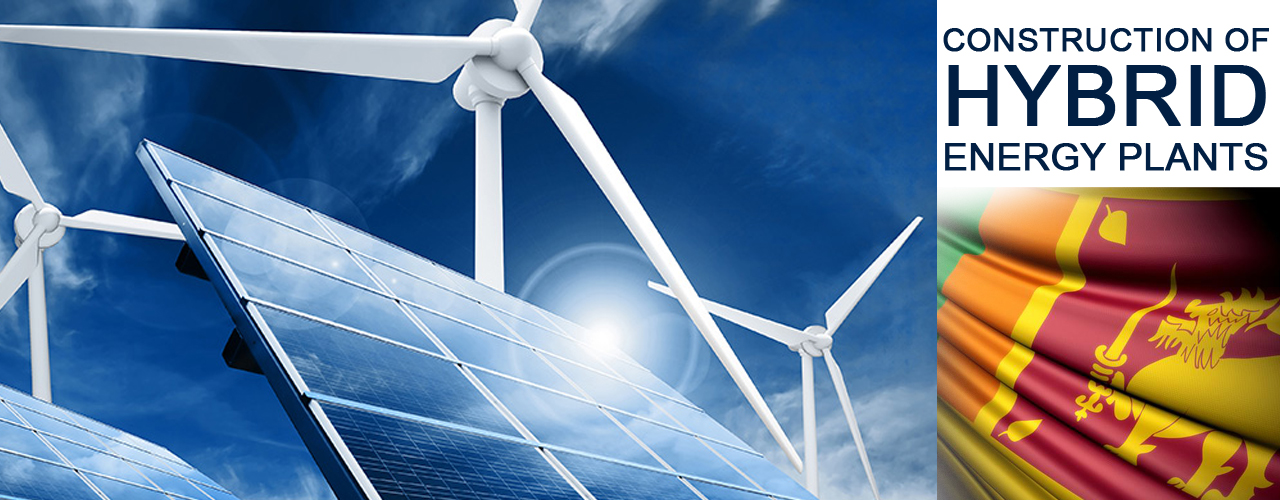Construction of hybrid energy plants.
Sri Lankan government is expected to move ahead with its plans to construct a 1040 MW hybrid wind and solar energy park in Pooneryn following approval granted from the cabinet of ministers. The approval was granted for hybrid renewable energy park to be constructed from which 240MW output from Wind and 800MW output from solar expected.
The energy park is to constructed in three stages over a period of 2 years. Also, lands amounting to approximately 6,000 hectares will also be acquired for this project also under three stages. First of three phases will be comprise of the construction of 120MW solar power and 150MW of Wind Power is expected to reach completion by 2022. The second phase which will add another 100MW of Wind Power and 100MW of Solar is expected to near completion by 2025 with the remaining work to be completed in full by 2030.
A statement detailing the decision read “By implementing the entire project, 1,800Gwh of electricity can be generated,” the statement said. “It can also reduce 1,050,000MT of carbon dioxide emission in power generation.” This reaffirms Sri Lankan governments’ commitment not only to shift towards renewable energy but its commitment for greener initiatives. A fact that was underlined by the 2017 budget when the government announced LKR 350 million or US$ 2.29 million for green building policy.
Pooneryn area has been chosen by the Sri Lanka Sustainable Energy Authority (SLSEA) due to its; suitability for wind and solar energy collection SLSEA had commented. However, this would also mean a project which has the potential to affect a war ridden and an underdeveloped region of Sri Lanka.
According to sources in SLSEA, Sri Lanka needs to produce at least 400MW through renewable energy sources in the coming years to address demands and Solar and Wind have been identified as the most suitable sources due to its availability across Sri Lanka.
This follows governments efforts to increase the percentage of renewable from its status of 10% currently, to 17% by the end of fourth quarter of 2019.This would mean an increase to 972MW from the current level of 442MW. The approval granted for the hybrid energy park is one of many initiatives by the Sri Lankan government to increase renewable energy in the country and it also has announced an upcoming tender for a 100MW floating solar panel on Maduru Oya Reservoir. All projects that are contributing towards renewable energy are expected to reach a capacity of 1897MW by 2034 with Wind Energy becoming a key stakeholder.
Sri Lanka’s energy demand is expected to grow approximately 5.9% per annum over the next half decade. Ceylon Electricity Board has already announced it plans to add at least 500MW to the national grid by 2018, which will consist of 15MW sourced from Mini Hydro plants, 160MW sourced from Solar, 5MW form Biomass and 320MW from oil based sources. However, from 2018 until 2037, there are plans to add 1389MW of solar, 1205 MW of wind, 842 of major hydro energy, 1500MW of Natural gas, 2700MW of Coal Power, 215 MW of mini Hydro plants, 425 MW from oil and 85MW from bio mass. Public Utilities Commission expects the entirety of the investment required over the next two decades will be roughly USD 14.568 billion.
OSL TAKE
Energy industry in Sri Lanka is on an upward trajectory buoyed by strong demand supplemented by newer players entering the industry as suppliers especially as renewable energy suppliers. Government decision to implement home based solar power projects have also fueled the strong growth and government has also provided incentives of buy back for private companies who are in the industry.
Currently around 70% of the demand is being supplied through the Ceylon Electricity Board who for the most part rely on Hydro Power Plants and Oil fueled power plants for the generation of electricity. However, with severe drought conditions affecting the production over the recent years, the production of electricity has come under pressure in some cases resulting in power cuts.
As a solution government is enticing private sector companies to come in and invest in developing energy production infrastructures especially in the area of renewable energy. With the government also committed to a green building policy and increasing the percentage of clean energy by substituting the energy of heavy power consuming devices such as Street Lights with renewable energy it is clear the industry is expanding at a rapid rate. Also, the number of licenses issued to private sector for such projects has also gone up signaling a more open and less bureaucratic market than in any other industry.
Demand for energy in Sri Lanka although is expected to go up at 5.9 per annum, with the industrial parks and many other manufacturing based industries coming in can be expected go high at a faster rate. Therefore allowing more market room and market share to be capitalized for potential investors, placing Renewable Energy Production as a very attracting proposition for investors.
| Article Code : | VBS/AT/03072017/Z_1 |

